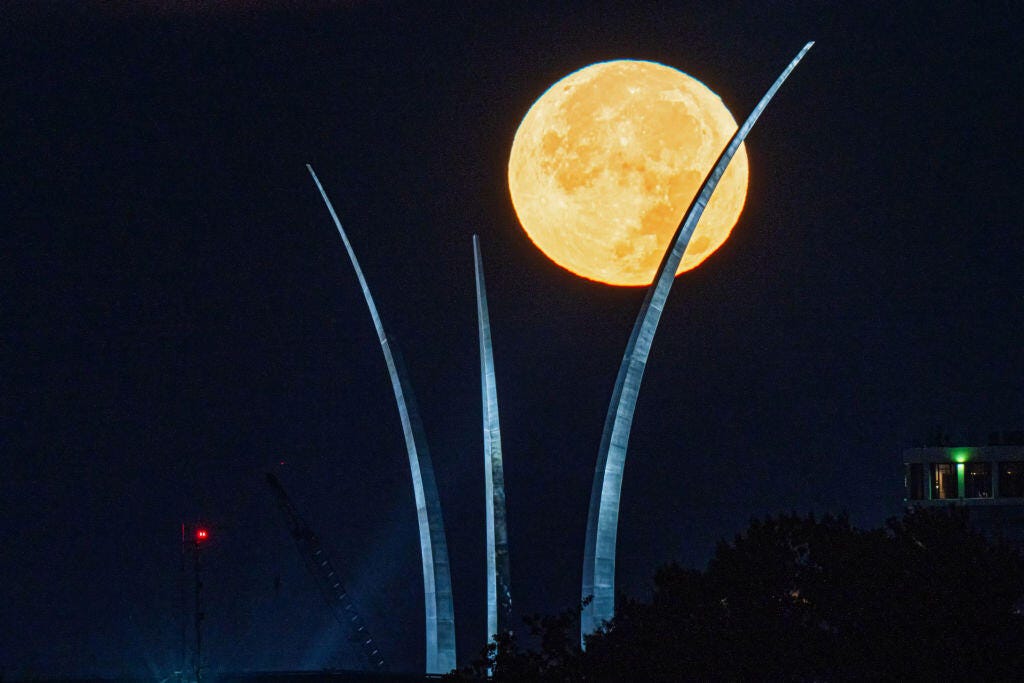
YOU'VE STILL GOT A CHANCE TO SEE THE RARE BLUE SUPERMOON
If you missed seeing the blue supermoon Monday night, get out there Tuesday or Wednesday. It'll still be plenty bright for the next few days. Although the moon was full on Aug. 19, Aug. 20 will feature a moon that is 98.8% full and the Aug. 21 moon will be 94.7% full.
What exactly is a supermoon? The moon will appear bigger and brighter tonight than the average full moon. The moon's orbit around Earth is elliptical, meaning that sometimes it's closer and sometimes further away. When the moon is at its closest, it's referred to as being at its perigee. When there is a full moon relatively close to the moon's perigee, it's referred to as a supermoon.
Supermoons appear physically larger in the sky and are noticeably brighter than average. By contrast, a minimoon occurs when the full moon is closer to its furthest point, which is known as the apogee. Minimoons are smaller and dimmer than average. NASA says that supermoons happen about three to four times a year.
The supermoon is also a seasonal blue moon. You may be familiar with the concept of a blue moon as the phenomenon of two full moons in a single month. A seasonal blue moon works the same way. Seasons are approximately three months long so we can typically expect three full moons. However, summer 2024 will have four full moons, which means we have a blue moon on our hands.
The first full moon of the summer took place on June 22, which was just two days into summer. Thanks to how the moon's 29.5-day cycle synced up, that means the fourth and final full moon of the summer will take place on Sept. 18, which is just four days from the first day of autumn. Typically, either June or September's full moon takes place in a different season, giving summer three full moons. Seasonal blue moons happen about once every two or three years.
The last couple of weeks of August are prime time for astronomy fans. Saturn and the moon are meeting up Tuesday night, a planet parade is due on Aug. 23, and there will be a meteor shower right at the end of the month.
Tips for viewing the supermoon
For the vast majority of the US, the moon will have risen or be rising by the time the sun sets in each region. However, the best time to view the moon will be around 10 to 11 p.m. local time, which gives the moon some time to get up into the sky. From there, you'll be able to view it all night.
Each month has a full moon and a name to go with it. In June, it's called the strawberry moon and in July, it's called the buck moon. For August, we call it the sturgeon moon. It's named after the fish, which is one of the oldest species of wildlife in North America. At 250 million years old, the sturgeon is often referred to as a living fossil. It's also the largest freshwater fish on the entire continent.
According to The Farmer's Almanac, August's moon is referred to as the sturgeon moon because the fish is more easily caught during this month and was an important food staple in bygone eras. Sturgeons were much more abundant back then than they are today, but we still call the August's full moon a sturgeon moon.
How rare is a blue supermoon?
Each event in a vacuum isn't that rare. Supermoons happen three to four times a year, while seasonal blue moons happen every 2.5 or so years. The two happening together, on the other hand, occurs less frequently. The last blue supermoon occurred in Aug. 2023, so we've had one two years in a row.
We won't have another one in 2025 or even 2026. The next blue supermoon is forecast to occur in May 2027.
2024-08-19T19:11:05Z dg43tfdfdgfd